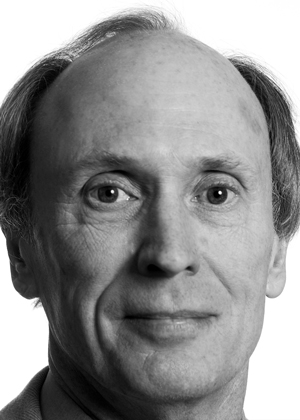Citation
Throughout his career Peter has inspired students and fellow geophysicists with his scientific insight and explanations and has gained international respect as a leader in studies that have improved our understanding of the structure and dynamics of the Earth’s interior. Peter has made significant scientific advances related to both the mantle and core of the Earth, two very different regimes requiring very different research expertise. Peter has accomplished this via two different approaches: numerical modeling and laboratory experiments.
Peter developed some of the original models of tectonic plate motions coupled to convectively driven mantle flows and of heterogeneous chemical composition of the mantle due to subducting slabs and rising plumes. He supported these theories and model simulations with the first laboratory experiments using variable-viscosity corn syrups, which provided explanations for surface observations like “trench rollback” and seismic observations like subducting slab deformation and partial penetration into the lower mantle. Peter is a coauthor of the comprehensive book Mantle Convection in the Earth and Planets (2001), which reviews the huge advances made over many decades in our understanding of mantle dynamics.
Peter has also studied the Earth’s core using numerical simulation and laboratory experiments. He motivated and led the first parametric study of hundreds of planetary dynamo simulations to learn how the structure, intensity, and time dependence of the resulting magnetic fields depend on various parameters of the model. His work led to the identification of different regions in parameter space that determine the frequency of dipole reversals based on convective versus rotational effects. In one region dominated by rotation Peter showed that magnetic dipole reversals do not occur; in another dominated by convection dynamos continuously reverse, and between these two regions the dynamo only occasionally produces dipole reversals. The geodynamo falls into this third parameter regime. Using laboratory experiments, Peter demonstrated how a rapidly rotating and strongly convecting sphere of fluid produces columnar flow patterns, which are critical for the geodynamo. He also conducted experimental studies of magnetoconvection and the growth of the Earth’s inner core. By organizing and editing Core Dynamics, volume 8 in the Treatise on Geophysics (2007), Peter provided a valuable resource that describes our current understanding of the Earth’s core.
—Gary A. Glatzmaier, University of California, Santa Cruz
Response
Thank you, Gary, for the generous citation and for working with other colleagues to advance my nomination for the Lehmann Medal. I am very aware that recognition like this stems from the efforts of many folks, and it is humbling and deeply satisfying to be selected as a contributor to our understanding of the deep Earth.
I first became an American Geophysical Union member in 1978, and it is remarkable to recall the limited state of understanding of the vast region of the lower mantle at that time. Seismic velocity models and associated geodynamical and mineralogical interpretations were not dramatically different from those available in the days of Inge Lehmann’s seminal work on the inner core. The accumulation of analogue recordings by the worldwide standardized seismological network and advances in numerical methods for computing seismic waves for one-dimensional Earth models had set the stage for moving forward, but few seismologists were working on deep-mantle problems. Indeed, my own work with Don Helmberger was initially focused on quantifying upper mantle lateral variations, and when we first advanced interpretations of deep-mantle discontinuity structure, the general response by the few who cared was rather dismissive skepticism.
Fast-forwarding to today, progress has been dazzling, with a large and vigorous international interdisciplinary research community advancing the frontiers of our knowledge. This is reflected in a proliferation of unpronounceable acronyms like LLSVP (large low-shear velocity provinces), ULVZ (ultralow velocity zones), and pPv (postperovskite) and the integrated efforts by organizations like SEDI (Study of the Earth’s Deep Interior) to understand the detailed chemistry, transport properties, and evolution of the deep mantle and core. Topics such as deep-mantle anisotropy, barely suggested in work preceding 1978, now engage joint seismological, geodynamical, and mineralogical modeling efforts that build upon state-of-the-art capabilities of different disciplinary efforts.
Our understanding of the deep mantle and core is now sophisticated, but great uncertainties and challenges remain; I am sure that the next generation of results will revise some of our current paradigms, and hopefully, it will provide new acronyms that are easier to say.
I’ve been very fortunate to work on seismology of the deep mantle and core with wonderful mentors, colleagues, and graduate students, along with receiving institutional support from great programs at the California Institute of Technology (Caltech), the University of Michigan, and the University of California, Santa Cruz. This recognition is shared among us all, and I deeply appreciate the many collaborations.
—Peter Olson, Johns Hopkins University, Baltimore, Md.
Citation: AGU (2015), Peter Olson receives 2015 Inge Lehmann Medal, Eos, 96,doi:10.1029/2015EO041307. Published on 29 December 2015.
Text © 2015. The authors. CC BY-NC 3.0
Except where otherwise noted, images are subject to copyright. Any reuse without express permission from the copyright owner is prohibited.

